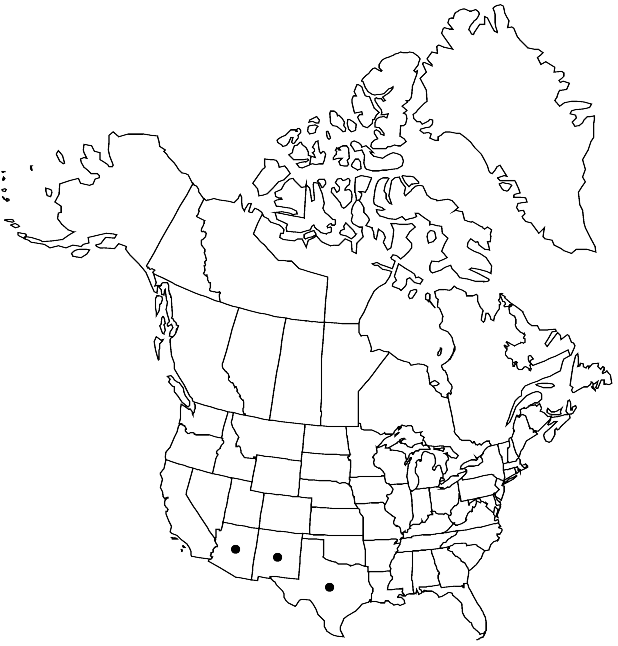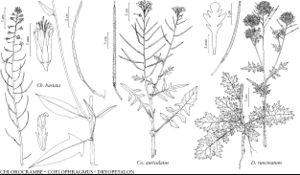Difference between revisions of "Dryopetalon runcinatum"
Smithsonian Contr. Knowl. 5(6): 12, plate 11. 1853.
FNA>Volume Importer |
imported>Volume Importer |
||
| (5 intermediate revisions by 2 users not shown) | |||
| Line 6: | Line 6: | ||
|place=5(6): 12, plate 11. 1853 | |place=5(6): 12, plate 11. 1853 | ||
|year=1853 | |year=1853 | ||
| + | }} | ||
| + | |special_status={{Treatment/ID/Special_status | ||
| + | |code=F | ||
| + | |label=Illustrated | ||
}} | }} | ||
|basionyms= | |basionyms= | ||
| Line 11: | Line 15: | ||
|name=Coelophragmus umbrosus | |name=Coelophragmus umbrosus | ||
|authority=(B. L. Robinson) O. E. Schulz | |authority=(B. L. Robinson) O. E. Schulz | ||
| + | |rank=species | ||
}} {{Treatment/ID/Synonym | }} {{Treatment/ID/Synonym | ||
|name=Dryopetalon runcinatum var. laxiflorum | |name=Dryopetalon runcinatum var. laxiflorum | ||
|authority=Rollins | |authority=Rollins | ||
| + | |rank=variety | ||
}} {{Treatment/ID/Synonym | }} {{Treatment/ID/Synonym | ||
|name=Sisymbrium umbrosum | |name=Sisymbrium umbrosum | ||
| − | |authority= | + | |authority= |
| + | |rank=species | ||
}} | }} | ||
|hierarchy=Brassicaceae;Brassicaceae tribe Thelypodieae;Dryopetalon;Dryopetalon runcinatum | |hierarchy=Brassicaceae;Brassicaceae tribe Thelypodieae;Dryopetalon;Dryopetalon runcinatum | ||
| Line 41: | Line 48: | ||
-->{{#Taxon: | -->{{#Taxon: | ||
name=Dryopetalon runcinatum | name=Dryopetalon runcinatum | ||
| − | |||
|authority=A. Gray | |authority=A. Gray | ||
|rank=species | |rank=species | ||
| Line 55: | Line 61: | ||
|publication title=Smithsonian Contr. Knowl. | |publication title=Smithsonian Contr. Knowl. | ||
|publication year=1853 | |publication year=1853 | ||
| − | |special status= | + | |special status=Illustrated |
| − | |source xml=https:// | + | |source xml=https://bitbucket.org/aafc-mbb/fna-data-curation/src/2e0870ddd59836b60bcf96646a41e87ea5a5943a/coarse_grained_fna_xml/V7/V7_1184.xml |
|tribe=Brassicaceae tribe Thelypodieae | |tribe=Brassicaceae tribe Thelypodieae | ||
|genus=Dryopetalon | |genus=Dryopetalon | ||
Latest revision as of 22:30, 5 November 2020
Annuals or biennials; usually sparsely to densely hirsute proximally, rarely glabrous throughout. Stems erect, unbranched or branched basally, branched distally, 2–8 dm. Basal leaves: petiole (1–)2–6(–8) cm; blade spatulate to obovate in outline, lyrate, pinnatifid, or bipinnately lobed, (2–)4–20(–25) cm × 30–80 mm, surfaces glabrous or hirsute. Cauline leaves shortly petiolate or sessile; blade base not auriculate, similar to basal, smaller distally. Racemes lax or dense. Fruiting pedicels divaricate-ascending, 5–15(–20) mm, glabrous or pubescent. Flowers: sepals (2.5–)3.5–4.5(–5) × 1.5–2 mm; petals white to purplish, spatulate, 6–9(–11) × 2.5–3.5(–4.5) mm, claw 2.5–4(–5) mm, margins pinnatifid, 5–7(–11)-lobed, papillate basally; filaments papillate basally, median pairs 3–5 mm, lateral pair 2.5–4 mm; anthers oblong, 0.7–1 mm. Fruits linear, (straight or arcuate), 2–6 cm × 0.5–1.2 mm; ovules 60–110 per ovary; style 0.1–0.7(–1) mm. Seeds 0.6–0.8 × 0.4–0.6 mm, not winged. 2n = 24.
Phenology: Flowering Jan–May.
Habitat: Ledges, shade of boulders and cliffs, foothills, canyons, scrub woodlands, streambeds, rocky basalt, crevices
Elevation: 800-1900 m
Distribution

Ariz., N.Mex., Tex., Mexico (Chihuahua, Sinaloa, Sonora).
Discussion
Dryopetalon runcinatum is easily distinguished from other mustards in the flora area by having divided petals. In the United States, it is restricted to Cochise, Pima, Pinal, and Santa Cruz counties in Arizona, Catron, Dona Ana, Hidalgo, and Luna counties in New Mexico, and El Paso County in Texas.
Selected References
None.
